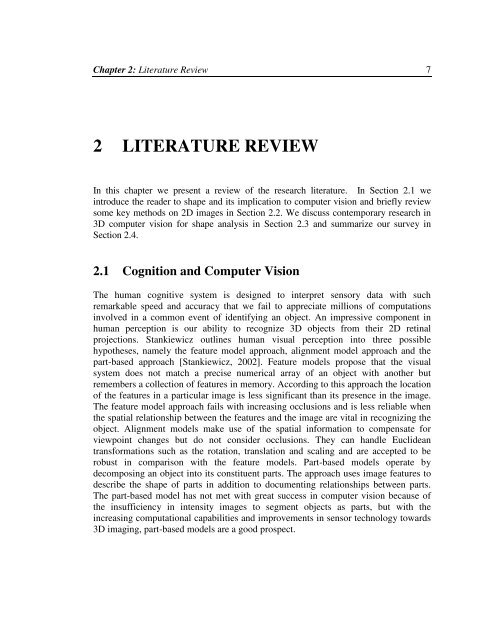To the Graduate Council: I am submitting herewith a thesis written by ...
To the Graduate Council: I am submitting herewith a thesis written by ...
To the Graduate Council: I am submitting herewith a thesis written by ...
Create successful ePaper yourself
Turn your PDF publications into a flip-book with our unique Google optimized e-Paper software.
Chapter 2: Literature Review 72 LITERATURE REVIEWIn this chapter we present a review of <strong>the</strong> research literature. In Section 2.1 weintroduce <strong>the</strong> reader to shape and its implication to computer vision and briefly reviewsome key methods on 2D images in Section 2.2. We discuss contemporary research in3D computer vision for shape analysis in Section 2.3 and summarize our survey inSection 2.4.2.1 Cognition and Computer VisionThe human cognitive system is designed to interpret sensory data with suchremarkable speed and accuracy that we fail to appreciate millions of computationsinvolved in a common event of identifying an object. An impressive component inhuman perception is our ability to recognize 3D objects from <strong>the</strong>ir 2D retinalprojections. Stankiewicz outlines human visual perception into three possiblehypo<strong>the</strong>ses, n<strong>am</strong>ely <strong>the</strong> feature model approach, alignment model approach and <strong>the</strong>part-based approach [Stankiewicz, 2002]. Feature models propose that <strong>the</strong> visualsystem does not match a precise numerical array of an object with ano<strong>the</strong>r butremembers a collection of features in memory. According to this approach <strong>the</strong> locationof <strong>the</strong> features in a particular image is less significant than its presence in <strong>the</strong> image.The feature model approach fails with increasing occlusions and is less reliable when<strong>the</strong> spatial relationship between <strong>the</strong> features and <strong>the</strong> image are vital in recognizing <strong>the</strong>object. Alignment models make use of <strong>the</strong> spatial information to compensate forviewpoint changes but do not consider occlusions. They can handle Euclideantransformations such as <strong>the</strong> rotation, translation and scaling and are accepted to berobust in comparison with <strong>the</strong> feature models. Part-based models operate <strong>by</strong>decomposing an object into its constituent parts. The approach uses image features todescribe <strong>the</strong> shape of parts in addition to documenting relationships between parts.The part-based model has not met with great success in computer vision because of<strong>the</strong> insufficiency in intensity images to segment objects as parts, but with <strong>the</strong>increasing computational capabilities and improvements in sensor technology towards3D imaging, part-based models are a good prospect.
















